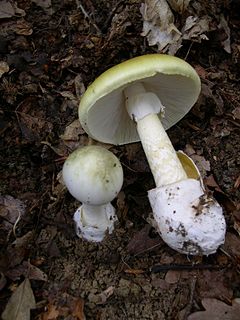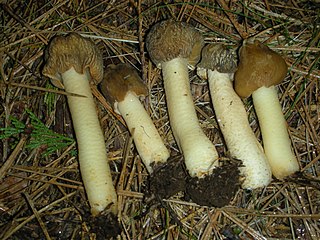
Edible mushrooms are the fleshy and edible fruit bodies of several species of macrofungi. They can appear either below ground (hypogeous) or above ground (epigeous) where they may be picked by hand. Edibility may be defined by criteria that include absence of poisonous effects on humans and desirable taste and aroma.

Morchella, the true morels, is a genus of edible sac fungi closely related to anatomically simpler cup fungi in the order Pezizales. These distinctive fungi have a honeycomb appearance due to the network of ridges with pits composing their cap. Morels are prized by gourmet cooks, particularly in French cuisine. Due to difficulties in cultivation, commercial harvesting of wild morels has become a multimillion-dollar industry in the temperate Northern Hemisphere, in particular North America, Turkey, China, the Himalayas, India, and Pakistan, where these highly prized fungi are found in abundance.

Mushroom hunting, mushrooming, mushroom picking, mushroom foraging, and similar terms describe the activity of gathering mushrooms in the wild, typically for food. This practice is popular throughout most of Europe, Australia, Japan, Korea, parts of the Middle East, and the Indian subcontinent, as well as the temperate regions of Canada and the United States.

Gyromitra esculenta, is an ascomycete fungus from the genus Gyromitra, widely distributed across Europe and North America. It normally fruits in sandy soils under coniferous trees in spring and early summer. The fruiting body, or mushroom, is an irregular brain-shaped cap dark brown in colour that can reach 10 cm (4 in) high and 15 cm (6 in) wide, perched on a stout white stipe up to 6 cm (2.4 in) high.
Gyromitrin is a toxin and carcinogen present in several members of the fungal genus Gyromitra, like G. esculenta. It is unstable and is easily hydrolyzed to the toxic compound monomethylhydrazine. Monomethylhydrazine acts on the central nervous system and interferes with the normal use and function of vitamin B6. Poisoning results in nausea, stomach cramps, and diarrhea, while severe poisoning can result in convulsions, jaundice, or even coma or death. Exposure to monomethylhydrazine has been shown to be carcinogenic in small mammals.

Mushroom poisoning refers to harmful effects from ingestion of toxic substances present in a mushroom. These symptoms can vary from slight gastrointestinal discomfort to death. The toxins present are secondary metabolites produced by the fungus. Mushroom poisoning is usually the result of ingestion of wild mushrooms after misidentification of a toxic mushroom as an edible species. The most common reason for this misidentification is close resemblance in terms of colour and general morphology of the toxic mushrooms species with edible species. To prevent mushroom poisoning, mushroom gatherers familiarize themselves with the mushrooms they intend to collect, as well as with any similar-looking toxic species. The safety of eating wild mushrooms may depend on methods of preparation for cooking.

Gyromitra gigas, commonly known as the snow morel, snow false morel, calf brain, or bull nose, is a fungus and a member of the Ascomycota. G. gigas is found in Europe. It is referred to as one of the false morels, due to its similar appearance and occurrence in the spring and early summer in similar habitats to true morels. It is edible if properly prepared but should be avoided due to variability and similarity to other more toxic species of Gyromitra. A similar species, Gyromitra montana occurs in North America.

Gyromitra is a genus of ascomycete mushrooms found in the northern hemisphere. The genus contains about 18 species.

Gyromitra infula, commonly known as the hooded false morel or the elfin saddle, is a fungus in the family Helvellaceae. The dark reddish-brown caps of the fruit bodies develop a characteristic saddle-shape in maturity, and the ends of both saddle lobes are drawn out to sharp tips that project above the level of the fruit body. The stipe is white or flushed pale brown, smooth on the outside, but hollow with some chambers inside. It is found in the Northern Hemisphere, usually in the late summer and autumn, growing on rotting wood or on hard packed ground. G. infula is considered inedible as it contains the toxic compound gyromitrin, which, when metabolized by the body, is converted into monomethylhydrazine, a component of some rocket fuels. The toxin may be removed by thorough cooking. Gyromitra fungi are included in the informal category "false morels".

Gyromitra ambigua is an ascomycete fungus species of the genus Gyromitra, and related to the false morel G. esculenta. It belongs to the Pezizales order. The species is found in North America, where it produces fruit bodies (mushrooms) that grow on the ground. The edibility of the fruit bodies is not known with certainty, and it is not recommended for consumption.

Gyromitra caroliniana, known commonly as the Carolina false morel or big red, is an ascomycete fungus of the genus Gyromitra, within the Pezizales group of fungi. It is found in hardwood forests of the southeastern United States, where it fruits in early spring soon after snowmelt. Although it is collected and eaten by some, there is some suggestion it may contain the toxic compound gyromitrin like its poisonous relative, the false morel G. esculenta, and for this reason it is usually not recommended for consumption.

Verpa is a genus of ascomycete fungi related to the morels. Resembling the latter genus in edibility and form, the common name early morels is popular. There are five species in the widespread genus.

The Discinaceae are a family of ascomycete fungi, the best known members of which are the false morels of the genus Gyromitra. Originally erected by Erich Heinz Benedix in 1961, it was found to be a discrete clade in a molecular study of ribosomal DNA by mycologist Kerry O'Donnell in 1997. As of 2008, the family is thought to contain 5 genera and 58 species.

Discina is a genus of ascomycete fungi related to the false morels of the genus Gyromitra. There are about 20 species in the genus. They bear dish- or cup-shaped fruit bodies. The best known member is the pig ear (D. perlata), which is deemed edible after thorough cooking, although is viewed with suspicion given its relation to the highly toxic false morels.

The Morchellaceae are a family of ascomycete fungi in the order Pezizales. According to a standard reference work, the family has contained at least 49 species distributed among 4 genera, but in 2012, 5 genera producing the sequestrate and hypogeous ascoma were added. The best-known members are the highly regarded and commercially picked true morels of the genus Morchella, the thimble morels of the genus Verpa, and a genus of cup-shaped fungi Disciotis. The remaining four genera produce the sequestrate fruit bodies.

Morchella elata is a species of fungus in the family Morchellaceae. It is one of many related species commonly known as black morels, and until 2012 the name M. elata was broadly applied to black morels throughout the globe. Like most members of the genus, M. elata is a popular edible fungus and is sought by many mushroom hunters.

Verpa conica, commonly known as the bell morel or the thimble fungus, is a species of fungi in the family Morchellaceae. Sometimes mistaken for a true morel, this species is a "false morel" characterized by a cap resembling a thimble that is freely attached to the stem.

Verpa bohemica is a species of fungus in the family Morchellaceae. Commonly known as the early morel or the wrinkled thimble-cap, it is one of several species known informally as a "false morel". The mushroom has a pale yellow or brown thimble-shaped cap—2 to 4 cm in diameter by 2 to 5 cm long—that has a surface wrinkled and ribbed with brain-like convolutions. The cap hangs from the top of a lighter-colored, brittle stem that measures up to 12 cm (4.7 in) long by 1 to 2.5 cm thick. Microscopically, the mushroom is distinguished by its large spores, typically 60–80 by 15–18 µm, and the presence of only two spores per ascus.

Morchella semilibera, commonly called the half-free morel, is a species of fungus in the family Morchellaceae native to Europe and Asia.


















